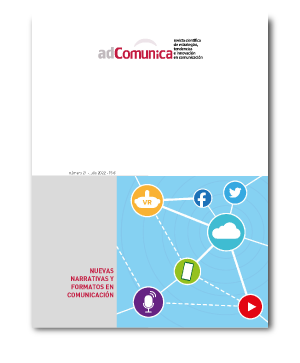Ecosistema y dinámicas de innovación en una narración digital interactiva de éxito: flujo de trabajo del webdoc Parir en el siglo XXI
##plugins.themes.bootstrap3.article.main##
Resum
Este artículo tiene como objetivo principal sistematizar el flujo de trabajo del webdoc de éxito Parir en el Siglo XXI para comprender la confluencia entre el proceso creativo innovador y la implicación de distintos actores de un ecosistema de innovación en el sector de la comunicación en España, sustanciado en una narrativa digital interactiva específica. Para ello, se ha realizado una investigación empírica en profundidad del proceso creativo de este webdoc basada en cuatro entrevistas en profundidad semi-estructuradas a todos los agentes responsables de este formato (Barret Cooperativa/RTVE Lab/À Punt Mèdia/Datadista) junto con el análisis del dossier creativo y maqueta de navegación proporcionados por Barret Cooperativa a efectos de esta investigación. Los resultados obtenidos muestran un modelo abierto de producción circular en el que se respeta la libertad creativa de creadores independientes y cada agente aporta valor desde su especialidad técnica, al mismo tiempo que se genera una cultura empresarial colaborativa auspiciada por la asesoría y apoyo financiero de entes públicos. Se detecta la necesidad de estandarización de los procesos de testeo de la experiencia del usuario, así como la creación de protocolos internos de evaluación de los factores de éxito de la narrativa digital interactiva estudiada.
Descàrregues
##plugins.themes.bootstrap3.article.details##
1. Política propuesta para Revistas que ofrecen Acceso Abierto
Los autores que publican en esta revista están de acuerdo con los siguientes términos:
- Los autores conservan los derechos de autor y garantizan a la revista el derecho de ser la primera publicación del trabajo al igual que licenciado bajo la licencia CC BY-SA, que permite a otros compartir el trabajo con un reconocimiento de la autoría del trabajo y la publicación inicial en esta revista.
- Los autores pueden establecer por separado acuerdos adicionales para la distribución no exclusiva de la versión de la obra publicada en la revista (por ejemplo, situarlo en un repositorio institucional o publicarlo en un libro), con un reconocimiento de su publicación inicial en esta revista.
Referències
Acar, Oguz A.; Tarakci, Murat y Van Knippenberg, Daan (2019). Creativity and innovation under constraints: A cross-disciplinary integrative review. En: Journal of Management, Vol.45, nº1. Londres: SAGE, 96-121. DOI: https://doi.org/10.1177/0149206318805832
Colapinto, Cinzia y Porlezza, Colin (2012). Innovation in Creative Industries: from the Quadruple Helix Model to the Systems Theory. En: Journal of Knowledge Economy, nº3. Cham: Springer, 343–353. DOI: https://doi.org/10.1007/s13132-011-0051-x
Fransman, Martin (2018). Innovation ecosystems: Increasing competitiveness. Cambridge: Cambridge University Press.
García-Avilés, Jose Alberto; de Lara, Alicia; Aria, Félix y Ortega, Alba (2016). El webdoc como herramienta de divulgación científica en Internet: el caso del Lab de RTVE1. En León, Bienvenido (Coord.): El medio ambiente en el nuevo universo audiovisual. Barcelona: Editorial UOC.
Godin, Benoit (2008). Innovation: The History of a Category. Projecto on the Intellectual Hisotry of Innovation. Working Paper 1. Consultado el 22 de julio de 2022 en https://espace.inrs.ca/id/eprint/10023/1/Godin_2008.pdf
Grandío Pérez, María del Mar (2010). Tiempo y perspectiva en la película Rashomon de Akira Kurosawa. En: Vivat Academia. Revista de Comunicación, nº111. Madrid: Universidad Complutense de Madrid, 87–105. DOI: https://doi.org/10.15178/va.2010.111.87-105
Grandío, María del Mar (2021). The Power of Context: Transmedia Storytelling Model for Interactive Narrative Design and Complexity. hal 03229669. Consultado el 22 de julio de 2022 en https://hal.archives-ouvertes.fr/hal-03229669/document
Koenitz, Hartmut (2010). Towards a Theoretical Framework for Interactive Digital Narrative. En Aylett, Ruth; Lim, Mei Yii; Louchart, Sandy; Petta, Paolo y Riedl, Mark (Eds.). Interactive Storytelling: Third Joint Conference on Interactive Digital Storytelling. Berlín: Springer.
Koenitz, Hartmut y Eladhari, Mirjam Palosaari (2019). Challenges of IDN Research and Teaching. En: Technologies for Interactive Digital Storytelling and Entertainment,Vol. 11869. Cham: Springer International Publishing, 26–39.
Kotsemir, Maxim; Abroskin, Alexander y Meissner, Dirk (2013). Innovation concepts and typology–an evolutionary discussion. En: Higher School of Economics Research Paper, nºWP BRP 05 05/STI/2013.
Li, Feng (2020). The digital transformation of business models in the creative industries: A holistic framework and emerging trends. En: Technovation, nº92. Ámsterdam: Elsevier, 102012. DOI: https://doi.org/10.1016/j.technovation.2017.12.004
Leydesdorff, Loet y Ahrweiler, Petra (2014). In search of a network theory of innovations: Relations, positions, and perspectives. En: Journal of the Association for Information Science and Technology, Vol.65, nº11. Hoboken: Wiley & Sons, 2359-2374. DOI: https://doi.org/10.1002/asi.23127
McLuhan, Marshall (1964). Understanding Media. The extensions of man Nueva York: McGraw Hill (trad. cast.: Comprender los medios de comunicación. Las extensiones del ser humano. Barcelona: Paidós, 1999).
Murray, Janet (1999). Hamlet en la holocubierta. El futuro de la narrativa en el ciberespacio. Barcelona: Paidós.
Ram, Jiwat; Cui, Binyue y Wu, Ming-Lu (2010). The conceptual dimensions of innovation: a literatura review. En Proceedings of the International Conference on Business and Information.Sapporo, 3-5 julio de 2010.
Zaragoza Fuster, María Teresa y García Avilés, José Alberto (2022). Public Service Media laboratories as communities of practice: implementing innovation at BBC News Labs and RTVE Lab. En: Journalism Practice. Nueva York: Taylor & Francis, 1-19. DOI: http://doi.org/10.1080/17512786.2022.2088602


